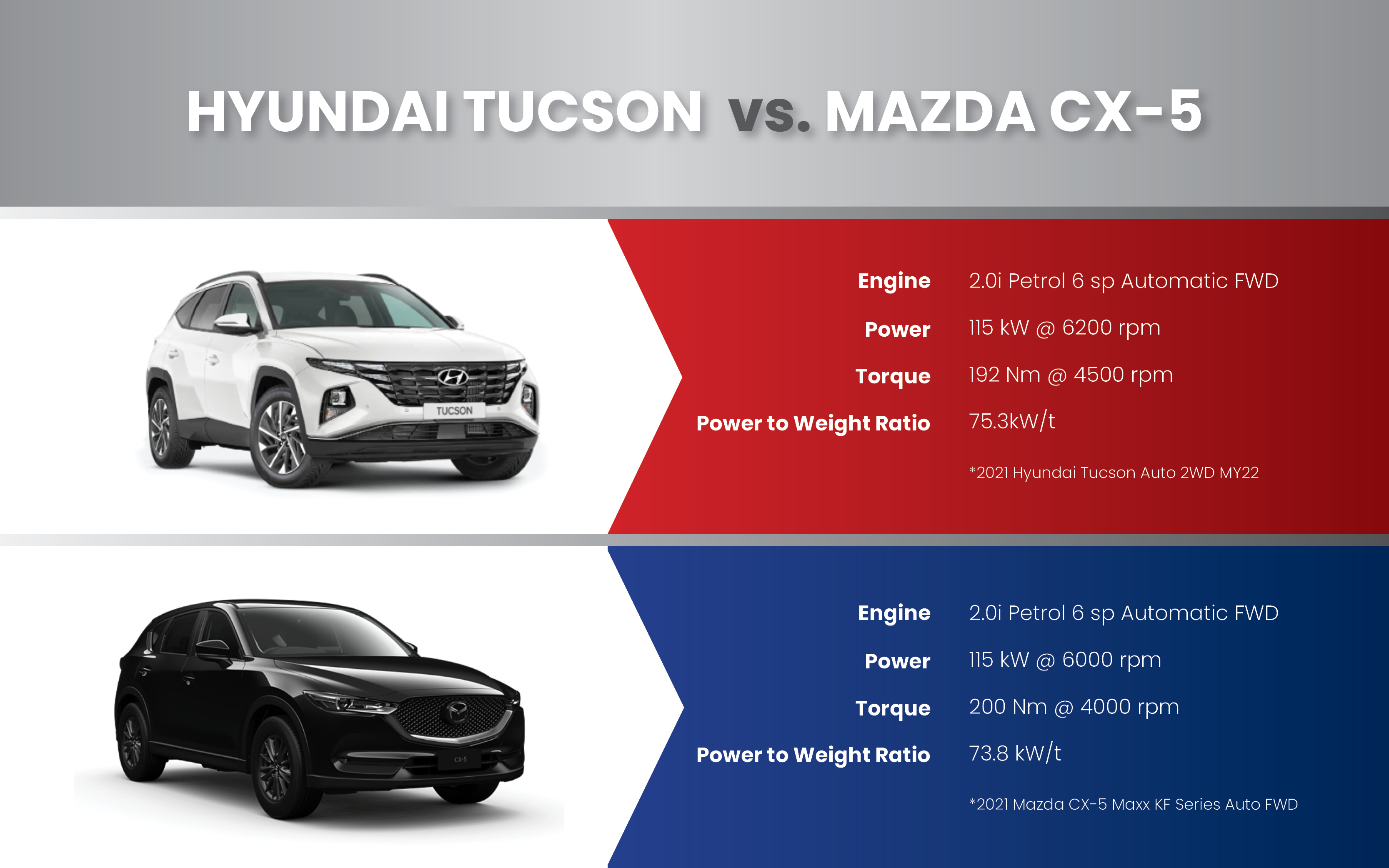
Hyundai Tucson vs Mazda CX-5
It's worth saying from the outset that it would be hard to describe the Hyundai Tucson as superior to the Mazda CX-5, or vice versa. Both are formidable, mid-size SUVs that come from well-known manufacturers. Ultimately, deciding which option is going to be best for you will be down to the little differences.
The qualities differentiating one vehicle from another will determine the better buy.
Here we take a look at various aspects of the Tucson and the CX-5. We compare and contrast the pros and cons of each.
Note that both base-spec models are priced similarly ($30,990 for a base-spec Tucson and $30,980 for a base-spec CX-5, using 2021 prices). With price not being a deciding factor, it's intriguing to see how these two market leaders compare with one another.
The Basics
Compared with the 2020 version, this year's Tucson has undergone a significant upgrade. Not only is the exterior sportier than previously, Hyundai has also revamped the interior (which, before was seen as a weak point). Up-to-date tech and the smart sense suite of safety features result in an SUV that's a pleasure to drive. It's reasonably fuel-efficient and available in two petrol variants and a diesel option.
The CX-5 is already Australia's second-best-selling SUV (behind the indomitable RAV4). In view of this, it's little surprise that the Mazda has got plenty going for it. The 2021 version includes an infotainment upgrade, some exterior tweaks and the addition of more safety features. Like the 2020 version, Mazda's focus on premium materials and a superior build-quality result in a formidable SUV. This helps to explain why it's been a popular choice for years.
Related: 2022 Hyundai Tucson vs Toyota Rav 4 Comparison
Interior
This time last year, it would have been fairly easy to choose the CX-5 as having the most appealing interior. With plenty of leather accents, a well set out cabin and a raft of features, it's definitely a great place to spend time in. Of particular note are the updated infotainment system and temperature adjustable front seats.
On the downside, some reviewers have reported that the seats aren't particularly comfortable. If you tend to drive for hours at a time, this could be a problem.
There is also the thorny issue of space.
The CX-5 dimensions are 1840mm (width), by 4550mm (length). In comparison, the Tucson measures 1865mm (width) and 4630mm (length). Whilst these differences don't seem like much, an extra couple of centimetres can make a big difference to passenger comfort.
Hyundai has gone all out on the Tucson's interior for 2021. Previously slated for being tacky and bland, the new interior features premium materials and some formidable tech.
Switches and buttons on the central console are replaced with modern capacitive touch technology. This feature is one that some drivers love and others hate. Reviewers have commented positively on the comfort the Tucson provides.
The Hyundai is also that little bit roomier than the CX-5, which is important given that space is a priority in any SUV.
Exterior
Hyundai has given the Tucson a sporty makeover, which can be further enhanced through the N line add-on, which should be coming later this year and will definitely be available in 2022. The Hyundai has lost its boxy shape, gaining some curves as well as a reworked front and rear end. LED headlights and privacy glass in the rear windows provide engaging touches.
Drivers opting for the N-line package can also benefit from 19" alloys, a black grille, a body kit, silver skid plates and more.
The exterior is very distinctive, which means inevitably some people will be drawn to the new look and others not so much. In comparison, the CX-5 retains a fairly bland exterior, but with the sportier GT SP styling option if required.
Performance
Overall, it's probably fair to say that the CX-5's driving performance is superior in terms of sheer power. Aside from torque, other aspects of performance are, perhaps surprisingly, pretty well matched.
The CX-5 offers a choice of three engines: a 2.5l naturally aspirated petrol, as well as a turbo-charged, 4-cylinder option and a 2.2l turbo-diesel engine. These deliver, respectively, 140kw/252Nm torque, 170kw/420Nm torque and 140kw/450Nm torque. Fuel consumption for the non-turbo is about 7.4l/100km, 8.2l/100km for the turbo and 5.7l/100km for the diesel.
In comparison, the Tucson also comes in three engine variants: 2l non-turbo base-spec petrol engine provides 115kw/192Nm torque. There is a 2.0l turbo-diesel (137kw/416Nm torque) and a turbo 4-cylinder 1.6l petrol engine that offers 132kw/265Nm torque. Fuel consumption for the two petrol engines is around 7.81l/100km. Diesel consumption is around 6.31/100km.
Both vehicles have been rated highly for handling and suspension - the suspension in the Tucson has been set specifically for Australian roads, which is a nice touch.
Highlights

CX-5
- Strong tech features, including a remote start, updated infotainment screen that supports Apple Carplay and Android Auto, an electrically powered boot, dural climate control and a full suite of autonomous safety features.
- Excellent driving performance and a powerful engine.
- Luxurious interior, including leather detailing and even timber inlay in the higher-spec model (the Akera).
Tucson
- Striking exterior that makes a powerful statement.
- Revamped interior which incorporates high-end materials and a range of sophisticated tech.
- Use of capacitive touch controls to replace more traditional switches and dials.
- This is a vehicle that has a comfortable interior that's a great place to spend time.
- A roomy SUV.
Why you should buy a Tucson
The 2021 upgrade has made a significant positive difference to the Hyundai. It's also made it stand out from the herd, and, in some ways, that's not always a good thing. The striking exterior, for example, isn't to everyone's tastes. This means that resale can be tricky, so the Tucson may be best avoided if it's not intended to be a long-term vehicle.
It's a versatile vehicle that's comfortable over longer distances and can seat second-row passengers in comfort. Different driving modes, as well as the option of AWD or FWD, augment a solid driving performance. With plenty of upgrades available if required, this is an SUV that's ideal for the daily commute, family adventures and the occasional longer trip.
Read Our 2022 Hyundai Tucson Full Review
Why you should buy a CX-5
Mazda's aim is to make high-end cars that are great to drive and feature a little touch of welcome luxury. The CX-5 is definitely a driver's car - plenty of features, power under the bonnet and smooth, consistent handling. If you tend to take longer trips, love to drive or enjoy challenging terrain, the CX-5 won't disappoint.
It's comfortable and, despite being slightly smaller than many SUVs in its class, it can seat three passengers in the second-row with no problem.
Good fuel economy and an excellent resale value are further benefits to this popular model. There's a reason that the CX-5 has consistently sold well. It really is a reliable, appealing car to own and drive.
Learn More About The 2022 Mazda CX-5
Final Verdict
Ultimately it's probable that the final verdict will depend on personal preferences. Hyundai delivers excellent technology, stunning aesthetics, comfort, space, and safety. In contrast, Mazda offers exceptional driving performance, a high-quality interior and features that appeal to drivers.
If you love to drive, drive frequently, or take longer trips, the CX-5 may well be a better bet. Its fuel efficiency and power are excellent.
The Tucson perhaps has the edge when it comes to tech, space and passenger comfort - it's a vehicle in which the needs of passengers are a priority, as well as the needs of the driver. For families looking for a long-term purchase that's reliable, versatile, spacious and a great place to spend time in, the Hyundai could be exactly what's needed.




